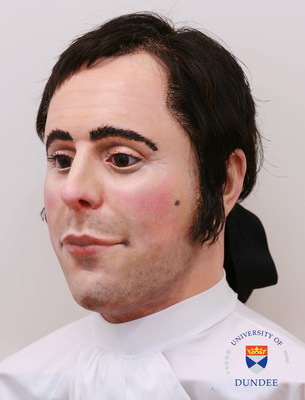Open any book of Burns’ work, and there will be someone’s impression of what he looked like somewhere in its pages. Taylor’s portrait has often been claimed to be most realistic, while the portrait by Nasmyth has, for many years, been the best known. Suggestions have been made that artists of the day were prone to embellishing their subject’s appearance for the sake of a better end result…… yes, and you thought air-brushing was a new thing.
Robert Burns died of rheumatic fever in Dumfries on 21st July 1796. He was originally buried in St. Michael’s churchyard in Dumfries but, in September 1815, his remains were moved to a purpose-built mausoleum in the corner of the churchyard paid for by public subscription. In 1834, the mausoleum was opened to allow Burns’ wife, Jean Armour, to be buried alongside him, and the opportunity was taken to make a plaster cast of the Bard’s skull. The cast then lay, for the most part undisturbed, for almost 200 years ……. until recently !
The University of Dundee is home to the Centre for Anatomy and Human Identification (CAHID) which is regularly contacted for advice and input in high-profile identification cases both at home and abroad. The CAHID Team has now featured in several television programmes, their most high profile member being Professor Sue Black who has recently been seen on BBC 2’s “History Cold Case.” The team has also carried out work to identify, amongst others, war dead in Bosnia. Working along with Professor Black on many of the cases highlighted on television is Caroline Wilkinson, Professor of Craniofacial Identification at CAHID, who is best known for her work in forensic facial reconstruction, her most significant creation (until recently of course) was the head of King Richard III of England.
The task fell to Professor Wilkinson to work with the cast of Burns skull to see what she might come up with, and here it is :

The unmasking of Burns’ face featured in an STV Documentary called “In Search of Robert Burns” which was first shown in January 2013. The documentary unveiled the model of Robert Burns’ head, reconstructed using state-of-the art forensic technology by Professor Wilkinson and her team. The professor commented :
“To be able to reveal the 3D head of Burns to Scotland and the world is an immense privilege for us, and all the team have watched this head develop and take on character over the last year. Finally we can see this charismatic poet as others would have seen him in life, and it has not been disappointing. This project has been quite a challenge and an enormous responsibility. We assessed as much material as we could for this reconstruction, including skeletal and anatomical structure, facial proportions from the Reid miniature and the Miers silhouette, and texture details from the portraits. This 3D depiction is as accurate as possible based on the available information, and shows Burns in his full living glory.”
‘Let it Blaw’ wishes to thank Caroline Wilkinson and her team at the University of Dundee for their amazing work, not to mention skill, which has helped bring Robert Burns “back to life.”
We also thank her for allowing the story to be told on our Club website, and thank Rab Wilson, past President of the New Cumnock Burns Club, for permission to use his photograph.
